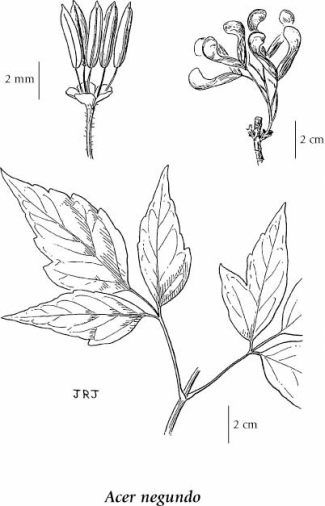box elder (Manitoba maple)
Sapindaceae (Horse-chestnut family)
(Previously in Aceraceae)
Introduction to Vascular Plants
Species Information
General:
Deciduous, spreading tree up to 20 m tall; young branches glabrous to finely hairy, light brown, becoming furrowed with age.
Leaves:
Opposite, pinnately compound, with 3-7 (9) leaflets, oblong-lanceolate to oblanceolate, coarsely few-toothed, usually hairy.
Flowers:
Inflorescence of racemes in dense axillary clusters on slender stalks, male and female flowers on separate trees; petals lacking.
Fruits:
Winged in pairs, 2.5-3.8 cm long, hairy, pairs attached in a V-shape.
Notes:
This species is probably naturalized in BC.
Illustration

If more than one illustration is available for a species (e.g., separate illustrations were provided for two subspecies) then links to the separate images will be provided below. Note that individual subspecies or varietal illustrations are not always available.
Illustration Source: The Illustrated Flora of British Columbia
USDA Species Characteristics
Flower Colour:
White
Blooming Period:
Early Spring
Fruit/Seed characteristics:
Colour: Brown
Present from Summer to Fall
Source: The USDA
Ecology
The table below shows the species-specific information calculated from
original data (BEC database) provided by the BC Ministry of Forests and Range.
(Updated August, 2013)
| Site Information |
Value / Class |
||
|
Avg |
Min |
Max |
|
| Elevation
(metres) |
620 | 330 | 1311 |
| Slope
Gradient (%) |
27 | 0 | 91 |
|
Aspect (degrees) |
262 | 260 | 265 |
| Soil
Moisture Regime (SMR) [0 - very xeric; 4 - mesic; 8 - hydric] |
4 | 2 | 5 |
| Modal
Nutrient Regime
Class |
D | ||
| #
of field plots species was recorded in: |
5 | ||
| Modal
BEC Zone Class |
IDF | ||
|
All BEC Zones (# of stations/zone) species was recorded in |
ESSF(1), IDF(2), PP(2) | ||
|
Source:
Klinkenberg 2013
|
|||
Habitat and Range
Mesic to dry sites in the lowland to montane zones; rare (sometimes garden escape) in S and NE BC; SE AB to W ON, disjunct along Great Lakes.Status Information
Taxonomic Keys
TAXONOMIC KEY TO ACER
1. Leaves pinnately compound; petals absent ..........A. negundo 2. Flowers 10-50; inflorescence racemose or in panicles; trees up to 30 m tall.
3. Leaves grey, white or purplish below, the stalks without milky juice when cut; inflorescence in long, hanging panicles; fruits glabrous ..........A. pseudoplatanus
4. Leaves lobed beyond the middle, the tips abruptly sharp-pointed; inflorescence racemose; fruits hairy ..........A. macrophyllum 2. Flowers usually less than 10; inflorescence umbellate or corymbose; plants usually shrublike and less than 10 m tall.
5. Leaves 3- to 5-lobed, glabrous to sparsely glandular short-hairy; sepals green.......... A. glabrum |